Text
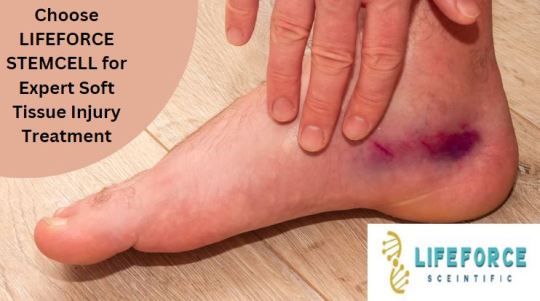
Choose LIFEFORCE STEMCELL for Expert Soft Tissue Injury Treatment
Suffering from soft tissue injury? You should consider regenerative medicine to treat soft tissue injury, whether caused by sports, accidents, or daily activities. Call us today for any query!
0 notes
Text
Soft Tissue Injuries - A Comprehensive and Expert Overview
Introduction:
Soft tissue injuries are common occurrences that can result from various causes, such as accidents, sports activities, or repetitive motion. The term "soft tissue" refers to muscles, tendons, ligaments, and other connective tissues that support and surround organs and structures in the body. Understanding the nature of soft tissue injuries is crucial for proper diagnosis, treatment, and rehabilitation.
Types of Soft Tissue Injuries:
Strains: Strains occur when muscles or tendons are stretched or torn due to excessive force or overuse. Common examples include hamstring strains from sports activities or lower back strains from lifting heavy objects improperly.
Sprains: Sprains involve the stretching or tearing of ligaments, the fibrous tissues that connect bones to each other. Ankle sprains are prevalent, often resulting from a sudden twist or turn during physical activities.
Contusions: Also known as bruises, contusions happen when blood vessels beneath the skin rupture due to direct impact. This type of injury is often associated with falls, collisions, or blunt trauma.
Tendinitis: Tendinitis occurs when tendons, the tissues that connect muscles to bones, become inflamed. This can happen gradually over time due to repetitive motion or sudden, intense activities.
Bursitis: Bursitis involves inflammation of the bursae, small sacs filled with fluid that cushion and lubricate joints. Repetitive motion or pressure on a particular joint can lead to bursitis, causing pain and limited mobility.
Symptoms and Diagnosis:
Soft tissue injuries share common symptoms, including pain, swelling, bruising, and reduced range of motion. Diagnosing these injuries often involves a thorough physical examination, medical history review, and, in some cases, imaging studies such as X-rays, MRIs, or ultrasound to assess the extent of damage.
Treatment and Rehabilitation:
The initial treatment for soft tissue injuries typically involves the R.I.C.E. protocol – Rest, Ice, Compression, and Elevation – to reduce swelling and pain. In more severe cases, medical intervention may be necessary, including physical therapy, pain management, or, in extreme cases, surgical intervention.
Rehabilitation is a crucial aspect of recovering from soft tissue injuries. Physical therapy focuses on strengthening and stretching exercises to restore flexibility, mobility, and strength. Rehabilitation programs are tailored to the specific injury, ensuring a gradual return to normal activities without risking further damage.
Prevention:
Preventing soft tissue injuries involves maintaining proper conditioning, warming up before physical activities, using proper techniques, and incorporating rest and recovery into one's routine. Adequate hydration and nutrition also play essential roles in overall soft tissue health.
Conclusion
Soft tissue injuries are a widespread and often painful part of life, but understanding their causes, symptoms, and treatments is crucial for effective management. Whether caused by sports, accidents, or daily activities, prompt and appropriate care can facilitate a smoother recovery and reduce the risk of long-term complications.
0 notes
Text
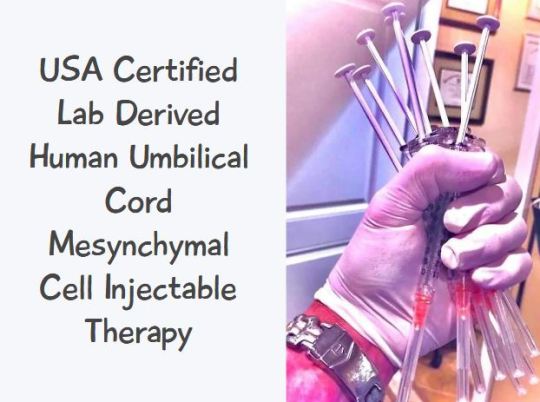
USA Certified Lab Derived Human Umbilical Cord Mesynchymal Cell Injectable Therapy
Experience the cutting-edge healthcare with USA Certified Lab Derived Human Umbilical Cord Mesenchymal Cell Injectable Therapy by LIFEFORCE STEMCELL . This therapy utilizes meticulously processed cells from human umbilical cords, meeting stringent quality standards, and offers potential benefits for various health conditions. Avail now!
0 notes
Text
Umbilical Mesenchymal Stem Cells - A New Era for Stem Cell Therapy
Introduction
In recent years, the field of regenerative medicine has witnessed remarkable advancements, with one of the most promising breakthroughs being the utilization of umbilical mesenchymal stem cells (UMSCs). Stem cells, known for their unique ability to differentiate into various cell types, hold immense potential for treating a myriad of diseases and injuries. Among these, UMSCs have emerged as a novel and powerful source of stem cells, unlocking new possibilities in the realm of stem cell therapy.
Unveiling the Power of UMSCs: Umbilical mesenchymal stem cells, derived from the Wharton's jelly of the umbilical cord, possess distinct advantages over other sources of stem cells. Unlike embryonic stem cells, UMSCs avoid ethical concerns, making them an ethical and readily available source. Moreover, they exhibit a higher proliferation rate and a lower risk of tumorigenesis compared to other adult stem cells, making them safer for therapeutic applications.
Regenerative Potential: UMSCs demonstrate remarkable regenerative potential, making them an ideal candidate for treating degenerative diseases and tissue injuries. These cells have the ability to differentiate into various cell types, including bone, cartilage, adipose tissue, and nerve cells, offering a versatile solution for a wide range of medical conditions. Their immunomodulatory properties also make them suitable for treating autoimmune disorders and inflammatory diseases.
Clinical Applications: The versatility and safety of UMSCs have led to their exploration in numerous clinical trials across the globe. Conditions such as osteoarthritis, spinal cord injuries, diabetes, and cardiovascular diseases are among the targeted areas of research. Early results have shown promising outcomes, with UMSCs demonstrating the ability to promote tissue repair, modulate immune responses, and enhance overall patient outcomes.
Challenges and Future Directions: While the potential of UMSCs in stem cell therapy is undeniable, challenges such as standardization of isolation protocols, long-term safety assessments, and scalability need to be addressed. Ongoing research aims to overcome these obstacles and further optimize the therapeutic potential of UMSCs.
Conclusion
Umbilical mesenchymal stem cells represent a new era in stem cell therapy, offering a potent and ethical source for regenerative medicine. As research progresses and clinical trials unfold, the use of UMSCs holds the promise of transforming the landscape of medical treatment, providing hope for countless individuals suffering from a variety of debilitating conditions. The journey of UMSCs from the umbilical cord to the forefront of regenerative medicine is a testament to the continuous evolution and innovation in the field of stem cell therapy.
0 notes
Text

Stem Cell Therapy and Regenerative Medicine by LIFEFORCE STEMCELL
For all your knee and joint pain problems, stem cell therapy and regenerative medicine by LIFEFORCE STEMCELL is your one-stop solution. It will treat many health conditions like heart disease, trauma, stroke, and autoimmune disorders. Get in touch today!
0 notes
Text
Hair Loss – Its Causes, Treatments and Prevention Options
Hair loss, medically known as alopecia, is a common condition that affects people of all ages and genders. While it is normal to lose some hair daily, excessive hair loss can be distressing and may indicate an underlying issue. Understanding the causes, available treatments, and prevention options can help individuals manage and cope with hair loss.
Causes: Hair loss can result from a variety of factors, including genetics, hormonal changes, medical conditions, and lifestyle choices. Androgenetic alopecia, commonly known as male-pattern baldness or female-pattern baldness, is the most common cause and is often hereditary. Hormonal changes due to pregnancy, childbirth, menopause, and thyroid problems can also contribute to hair loss. Medical conditions such as alopecia areata, lupus, and diabetes may lead to hair loss as well. Additionally, certain medications, stress, and poor nutrition can play a role in disrupting the hair growth cycle.
Treatments: Several treatment options are available to address hair loss, depending on the underlying cause. Topical treatments, such as minoxidil, are commonly used to promote hair growth and slow down hair loss. Prescription medications like finasteride can be effective for treating androgenetic alopecia in men. For individuals with autoimmune-related hair loss, corticosteroids and immunosuppressants may be prescribed. Surgical interventions, such as hair transplant procedures, are also available for those seeking more permanent solutions.
Prevention Options: While not all causes of hair loss are preventable, adopting a healthy lifestyle can contribute to maintaining hair health. Proper nutrition, including a diet rich in vitamins and minerals essential for hair growth, can make a difference. Avoiding excessive heat styling, tight hairstyles, and harsh chemical treatments can help prevent damage to the hair shaft. Managing stress through relaxation techniques and regular exercise can also positively impact hair health. Additionally, early intervention and seeking medical advice when noticing abnormal hair loss can prevent further progression.
In conclusion, understanding the causes, exploring available treatments, and adopting preventive measures are crucial aspects of hair loss management. While some factors may be beyond control, individuals can take proactive steps to promote healthy hair and address the condition effectively. Consulting with a healthcare professional or a dermatologist can provide personalized guidance based on the specific circumstances of each individual.
0 notes
Text
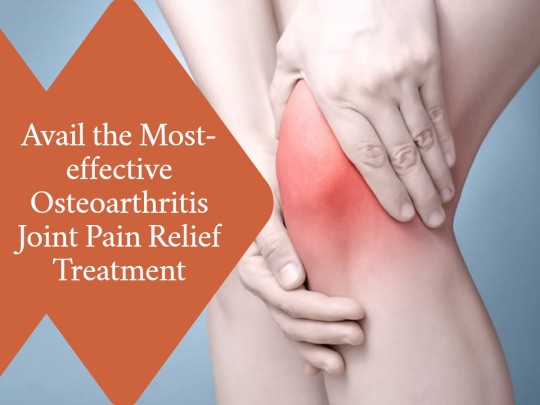
Avail the Most-effective Osteoarthritis Joint Pain Relief Treatment
Is your osteoarthritis or joint pain is limiting your daily routine? Regenerative medicine may be the answer you’ve been looking for. It is a new and trusted method to administer a natural, effective treatment for helping alleviate your injuries and avoid surgery. https://www.lifeforcestemcells.com/
0 notes
Text
Unlocking Radiance: Understanding Skin Rejuvenation and Its Mechanisms
Introduction:
Skin rejuvenation has become a buzzword in the realm of skincare, promising a renewed and youthful complexion. But what exactly is skin rejuvenation, and how does it work? In essence, skin rejuvenation refers to the process of enhancing the skin's appearance, minimizing signs of aging, and promoting overall skin health. From non-invasive treatments to cutting-edge technologies, various methods aim to rejuvenate the skin and unveil its natural radiance.
Understanding Skin Rejuvenation:
Skin rejuvenation encompasses a range of techniques designed to address common skin concerns such as wrinkles, fine lines, sun damage, and uneven skin tone. The primary goal is to stimulate the production of collagen and elastin, essential proteins that provide the skin with structure and elasticity. As we age, the production of these proteins decreases, leading to sagging skin and the formation of wrinkles.
How It Works:
Chemical Peels: Chemical peels involve the application of a chemical solution to remove the outer layer of the skin, promoting cell turnover. This process helps reduce fine lines, sunspots, and acne scars, revealing a smoother and more youthful complexion.
Laser Therapy: Laser treatments use focused light beams to target specific skin concerns. Fractional laser technology, for instance, creates controlled micro-injuries to stimulate collagen production, promoting skin renewal and a more youthful appearance.
Microdermabrasion: This non-invasive procedure involves exfoliating the outer layer of the skin using tiny crystals or a diamond-tipped wand. Microdermabrasion helps improve skin texture, reduce fine lines, and enhance overall skin tone.
Microneedling: Microneedling employs a device with tiny needles that puncture the skin, triggering the body's natural healing response. This stimulates collagen production and promotes skin rejuvenation, improving texture and reducing the appearance of scars and wrinkles.
Topical Treatments: Skincare products containing retinoids, antioxidants, and peptides play a crucial role in daily skin rejuvenation. These ingredients help promote collagen synthesis, protect against environmental damage, and maintain skin hydration.
Conclusion:
Skin rejuvenation is a dynamic and evolving field that offers a multitude of options to individuals seeking to revitalize their skin. Whether through professional treatments or a consistent at-home skincare routine, the key lies in stimulating collagen production and promoting skin renewal. As technology continues to advance, the quest for radiant and youthful skin remains an achievable goal for those willing to invest in the science of rejuvenation.
0 notes
Text
Unlocking the Potential of Umbilical Cord Stem Cells: Pros, Cons, and Promising Uses
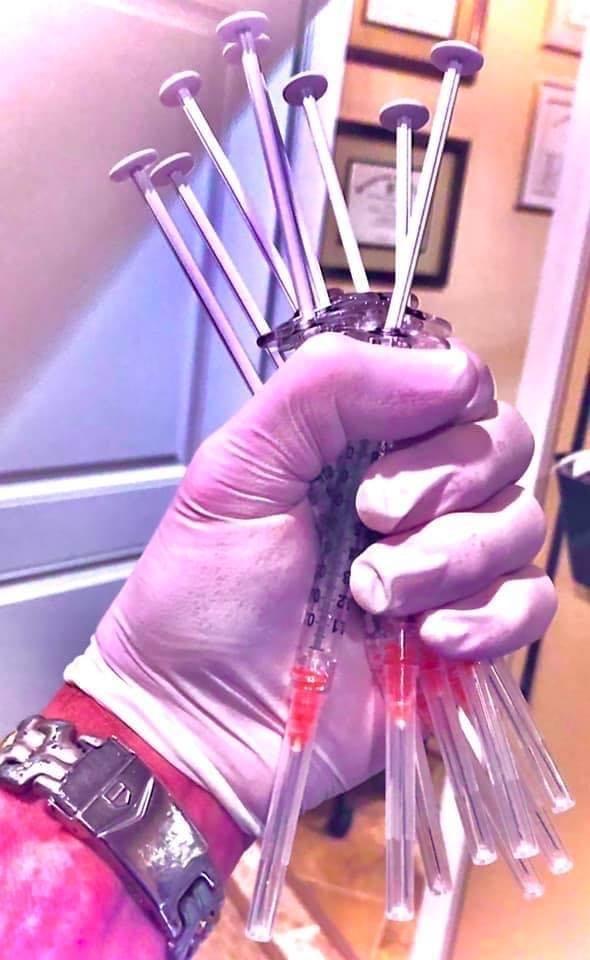
Introduction:
Umbilical cord stem cells have emerged as a revolutionary source of regenerative medicine, holding immense potential for treating various medical conditions. These cells, collected from the umbilical cord and placenta after childbirth, are rich in hematopoietic and mesenchymal stem cells. As with any medical advancement, the use of umbilical cord stem cells comes with its own set of pros, cons, and exciting applications.
Pros:
Rich Source of Stem Cells: Umbilical cord stem cells are abundant in both hematopoietic and mesenchymal stem cells. These cells have the unique ability to differentiate into various cell types, making them valuable for regenerating tissues, organs, and blood.
Ethical Considerations: Unlike embryonic stem cells, which raise ethical concerns, umbilical cord stem cells are harvested from the discarded placenta and umbilical cord after childbirth, posing no ethical dilemmas.
Reduced Risk of Transmissible Diseases: Compared to adult stem cells, umbilical cord stem cells have a lower risk of transmitting infections or diseases, making them a safer option for transplantation.
Improved Graft-versus-Host Disease (GvHD) Management: Studies suggest that the risk of GvHD, a common complication in stem cell transplantation, is lower with umbilical cord stem cells. This makes them a preferable choice for patients in need of hematopoietic stem cell transplantation.
Cons:
Limited Quantity: The quantity of stem cells obtained from the umbilical cord is relatively small compared to other sources. This limitation may affect the treatment of larger patients or those requiring multiple doses.
Restricted Match Availability: Finding a suitable match for transplantation can be challenging, as the donor's tissue type must closely match that of the recipient. This limitation may hinder widespread use.
Limited Storage Time: Umbilical cord blood must be processed and stored promptly after collection to ensure cell viability. Delayed processing or storage can compromise the quality and effectiveness of the stem cells.
Uses:
Blood Disorders: Umbilical cord stem cells are commonly used in treating various blood disorders, such as leukemia and sickle cell anemia, through hematopoietic stem cell transplantation.
Regenerative Medicine: These cells hold promise for regenerating damaged tissues and organs, offering hope for conditions like spinal cord injuries, heart diseases, and neurodegenerative disorders.
Immunotherapy: The unique properties of umbilical cord stem cells make them a potential resource for developing personalized immunotherapies, enhancing the body's ability to fight cancer and other diseases.
Conclusion:
Umbilical cord stem cells represent a remarkable advancement in medical science, offering numerous advantages while posing some challenges. As research continues, addressing the limitations and maximizing the potential of these cells could pave the way for groundbreaking treatments, bringing us closer to a future where regenerative medicine transforms the landscape of healthcare.
0 notes
Text
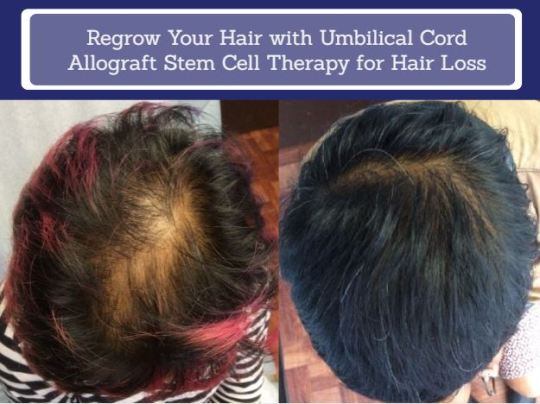
Regrow Your Hair with Umbilical Cord Allograft Stem Cell Therapy for Hair Loss
Don’t suffer more from baldness as LIFEFORCE STEMCELL is your one-stop source for hair regrowth. Our procedure for hair loss involves the injection of Umbillical Cord Allograft Mesenhcymal Stem Cells, which starts showing the hair regrowth results after 1 month. Get in touch today! https://www.lifeforcestemcells.com/
0 notes
Text
Tips on How to Recover From Sports Injuries
Engaging in sports is not only a source of enjoyment but also a means of maintaining physical fitness. However, the risk of sports injuries is an inherent part of any athletic activity. Whether you're a seasoned athlete or a weekend warrior, knowing how to recover from sports injuries is crucial to getting back in the game safely. Here are some valuable tips to help you navigate the path to recovery.
Seek Professional Guidance: When injured, it's essential to consult with a healthcare professional, such as a sports medicine doctor or a physiotherapist. They can accurately diagnose the extent of the injury and provide a tailored treatment plan. Ignoring professional advice may lead to exacerbating the injury and prolonging the recovery process.
Rest and Ice: Rest is a fundamental aspect of recovery. Allow your body the time it needs to heal by avoiding activities that may worsen the injury. Applying ice to the affected area can help reduce swelling and alleviate pain. Remember the acronym R.I.C.E.: Rest, Ice, Compression, and Elevation.
Follow a Rehabilitation Program: Once you receive the green light from your healthcare provider, engage in a structured rehabilitation program. This may involve specific exercises to strengthen the injured area, improve flexibility, and restore function. Consistency and patience are key to successful rehabilitation.
Gradual Return to Activity: Rushing back into sports too soon can lead to re-injury. Gradually reintroduce activities, starting with low-impact exercises and progressively increasing intensity. Listen to your body and be mindful of any signs of discomfort.
Cross-Train: While recovering from a specific injury, consider cross-training to maintain overall fitness without placing undue stress on the injured area. This could include activities like swimming, cycling, or yoga, which can provide a good balance between maintaining cardiovascular health and allowing the injured part to heal.
Proper Nutrition: A nutritious diet plays a vital role in the recovery process. Ensure you're getting adequate nutrients, including vitamins and minerals, to support tissue repair. Consult with a nutritionist if needed to optimize your diet for recovery.
Stay Positive and Patient: Recovery can be a challenging and sometimes frustrating journey. Maintain a positive mindset and be patient with the process. Celebrate small victories along the way, and focus on the progress you're making.
In conclusion, recovering from sports injuries requires a comprehensive approach that combines professional guidance, rest, rehabilitation, and a positive mindset. By following these tips, you can enhance your recovery and return to your favorite sports activities with strength and resilience. Remember, taking the time to heal properly is an investment in your long-term athletic success.
0 notes
Text
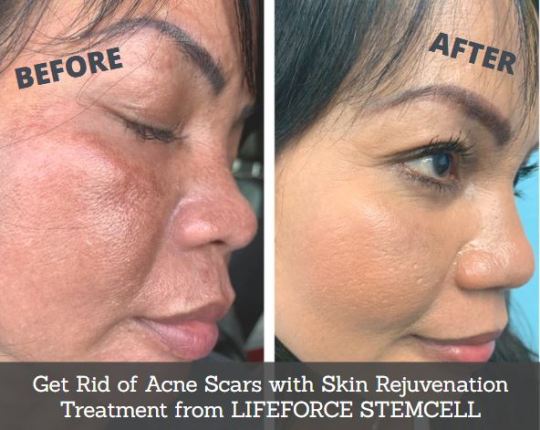
Get Rid of Acne Scars with Skin Rejuvenation Treatment from LIFEFORCE STEMCELL
Suffering from acne scars problem? Don’t worry; LIFEFORCE STEMCELL is your one-stop source. Stemcell has a regenerative effect on almost all the tissues in our body, thus provides skin rejuvenation and recovery from many other pathologies as well. Get in touch today!
0 notes
Text

LIFEFORCE STEMCELL – Safe Non Surgical Painless Answer to Arthritic Joint Pain
Suffering from arthritis joint pain? Don’t worry because LIFEFORCE STEMCELL is a safe and non surgical painless answer to arthritic joint pain. Here, STEMCELLS are painlessly performed by 100% medical staff only. Get in touch today!
0 notes
Text
Top 5 Ways to Get Relief from Arthritis Pain Naturally
Introduction:
Arthritis, a common condition affecting millions of people worldwide, can significantly impact one's quality of life by causing chronic pain and inflammation in the joints. While medical treatments are available, many individuals seek natural remedies to manage arthritis pain. Here are the top five ways to find relief from arthritis joint pain naturally.
Regular Exercise: Engaging in regular, low-impact exercises is crucial for managing arthritis pain. Activities such as swimming, walking, and gentle yoga can help improve joint flexibility and reduce stiffness. Exercise also promotes the production of endorphins, the body's natural painkillers, providing relief from arthritis symptoms. It is essential to consult with a healthcare professional or a physical therapist to develop a personalized exercise plan tailored to individual needs and limitations.
Maintain a Healthy Diet: A balanced and anti-inflammatory diet can play a significant role in managing arthritis pain naturally. Foods rich in omega-3 fatty acids, such as fish, flaxseeds, and walnuts, have anti-inflammatory properties that can help reduce joint pain. Additionally, incorporating fruits, vegetables, whole grains, and lean proteins can provide essential nutrients that support joint health. Limiting processed foods, sugar, and saturated fats can also contribute to overall well-being.
Hot and Cold Therapies: Applying heat or cold to affected joints can offer relief from arthritis pain. Warm compresses or heating pads can help relax muscles and alleviate stiffness, while cold packs can reduce inflammation and numb the pain. Alternating between hot and cold therapies, known as constrast therapy, can be particularly effective. It's important to use these therapies with caution, avoiding extremes in temperature to prevent skin damage.
Herbal Remedies and Supplements: Several herbs and supplements have shown promise in reducing arthritis symptoms. Turmeric, containing the active compound curcumin, possesses anti-inflammatory properties. Ginger and green tea are also known for their potential to alleviate pain and inflammation. Additionally, supplements like glucosamine and chondroitin may help support joint health, although individual responses vary. Before incorporating any herbal remedies or supplements into a routine, consulting with a healthcare professional is advisable.
Mind-Body Techniques: Stress and anxiety can exacerbate arthritis symptoms, making it essential to incorporate mind-body techniques for relaxation and stress management. Practices such as meditation, deep breathing exercises, and guided imagery can help reduce stress and, consequently, alleviate arthritis pain. These techniques not only enhance mental well-being but also contribute to overall pain management.
Conclusion: While arthritis may be a persistent condition, incorporating these natural approaches into a daily routine can provide significant relief from pain and improve the overall quality of life. It's crucial for individuals with arthritis to work closely with healthcare professionals to develop a comprehensive plan that addresses their unique needs and ensures a holistic approach to managing the condition.
0 notes
Text
How to Get the Best Pain Relief Treatment from FDA Registered Labs?
Pain relief is a critical aspect of managing discomfort and improving quality of life for individuals dealing with various conditions. When seeking effective pain relief treatments, it's crucial to turn to trusted and reputable sources. One such reliable avenue is through treatments provided by FDA registered labs, ensuring safety, efficacy, and adherence to stringent quality standards.
The Food and Drug Administration (FDA) is a regulatory body that oversees the safety and efficacy of medications, including pain relief treatments. FDA registered labs adhere to rigorous guidelines set by the FDA, ensuring that the products they manufacture are safe, effective, and of high quality. Here are steps to ensure you obtain the best pain relief treatment from these accredited labs:
Consult a Healthcare Professional: Before seeking any pain relief treatment, consult a healthcare professional. They can provide an accurate diagnosis and recommend appropriate pain relief options based on your specific condition and medical history.
Research FDA Registered Labs: Look for pharmaceutical companies and laboratories that are FDA registered. You can find this information on the FDA's official website or by directly contacting the manufacturer. Registered labs are held to higher standards of quality and safety, giving you confidence in the products they produce.
Review Product Information: Thoroughly read and understand the product information, including the active ingredients, usage instructions, potential side effects, and contraindications. Ensure that the pain relief treatment is suitable for your condition and aligns with your healthcare provider's recommendations.
Seek FDA Approved Medications: Look for pain relief medications that are FDA approved. FDA approval indicates that the treatment has undergone rigorous testing for safety and efficacy, giving you assurance of its quality and effectiveness.
Follow Dosage Instructions: Adhere to the recommended dosage and usage instructions provided by the healthcare professional and the product label. Avoid exceeding the prescribed dosage, as this could lead to unwanted side effects or potential harm.
Monitor Your Progress: Regularly monitor your pain levels and overall well-being while using the pain relief treatment. If you experience any adverse effects or if the treatment is not providing the desired relief, consult your healthcare professional promptly.
Stay Informed and Updated: Stay informed about advancements in pain relief treatments and consult your healthcare provider for any updates or changes in your treatment plan. Keeping up-to-date with relevant information ensures you are using the most effective and safe pain relief solutions.
In conclusion, obtaining the best pain relief treatment involves careful consideration and adherence to guidelines set by FDA registered labs. By consulting healthcare professionals, researching approved medications, and following proper usage instructions, you can ensure a safe and effective approach to managing your pain.
0 notes
Text
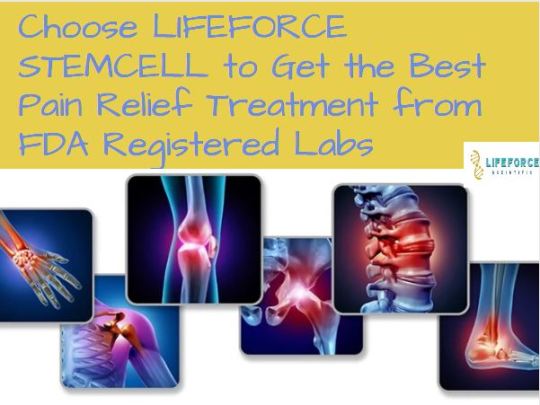
Choose LIFEFORCE STEMCELL to Get the Best Pain Relief Treatment from FDA Registered Labs
Have you injured your knee, ACL or MCL ligaments? You should consider regenerative medicine, a safe non surgical painless answer to treat your knee injury. 100% medical staff only; get in touch today! https://www.lifeforcestemscells.com/
1 note
·
View note